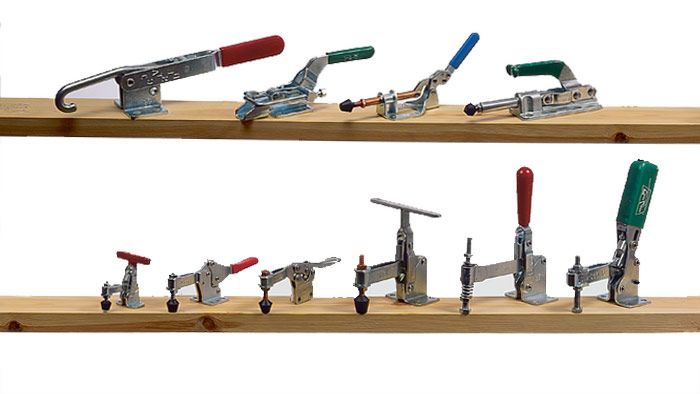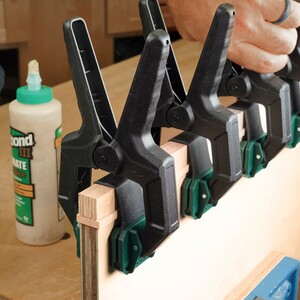Toggle Clamps
Get a grip on workshop problems with these handy devices
Synopsis: Toggle clamps exert exceptional holding force, have a positive locking action, and are fast and easy to use with just one hand. They’re reasonably priced, too. In this article, Ed Hoffman discusses mechanical toggle clamps, hold-down clamps, straight-line clamps, pull-action clamps, squeeze-action clamps, and automatic toggle clamps. A side article by Douglas W. Ruffley talks about how to use toggle clamps, covering setup, optional spindles, and jig considerations.
We’ve all done it—hand-held that small piece of wood to drill, shape or cut it on a power tool while thinking there must be a safer way to do the job. Those of us who were lucky can still count 10 fingers. The others will wish they had heard of toggle clamps before they made that cut. It’s been more than 50 years since the Detroit Stamping Co., now De-Sta-Co, introduced the toggle clamp. Although there are more manufacturers today and toggle clamps are available from most woodworking mail-order sources, the clamps are just now appearing with regularity in woodworking shops. Toggle clamps exert exceptional holding force, have a positive locking action and are fast and easy to use with just one hand. These features combined with reasonable cost ($5 to $20 for most clamps) make toggle clamps ideal for holding workpieces to jigs, fixtures and workshop tools.
Toggle clamps operate through a system of pivots and levers joined together so force applied to the knee lever (or handle) straightens the arrangement of pivot points and creates endways pressure on the mechanism. When fully extended to its locked position, the middle pivot point is moved slightly beyond the center line of the outer pivot points. The clamping force now creates endways pressure to push the middle pivot point down against a stop, locking the toggle clamp in position.
Mechanical toggle clamps
Toggle clamps come in a dizzying variety of styles. In fact, toggle clamps offer more mechanical, pneumatic and hydraulic variations than any other type of clamp. Some of the major differences in the mechanical clamps are the handle design (arrangement and placement), mounting styles and holding capacity. Holding capacity, which ranges from 60 lbs. to 16,000 lbs., is defined as the maximum amount of force that can be applied to the clamping bar in the closed position without permanently deforming the clamp.
From Fine Woodworking #96
For the full article, download the PDF below:
Fine Woodworking Recommended Products

Starrett 12-in. combination square

Bahco 6-Inch Card Scraper

Olfa Knife





















Log in or create an account to post a comment.
Sign up Log in